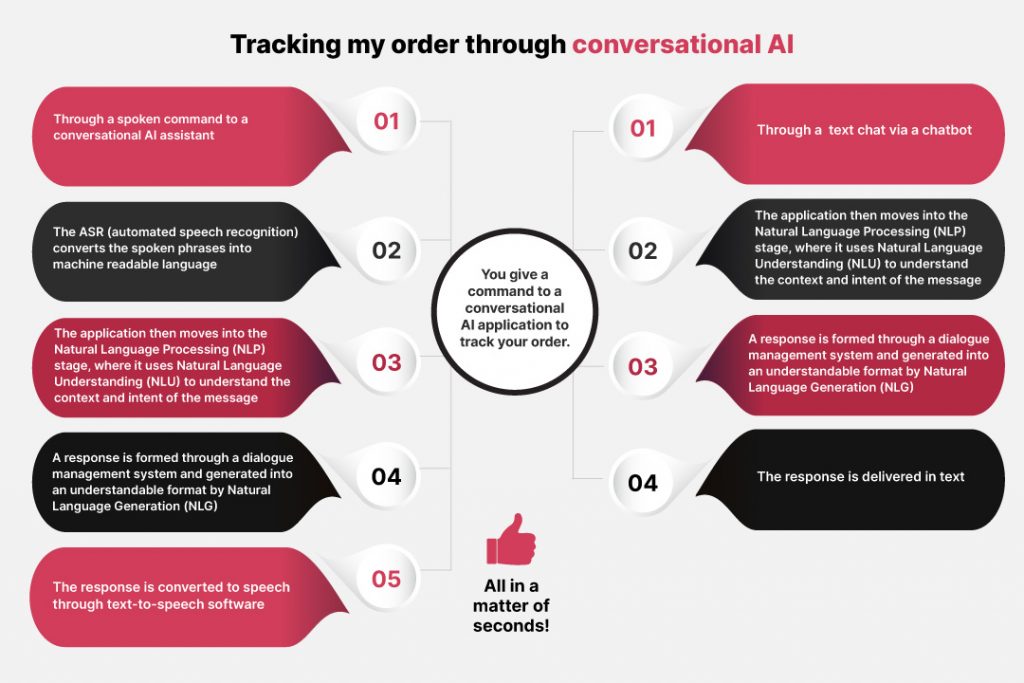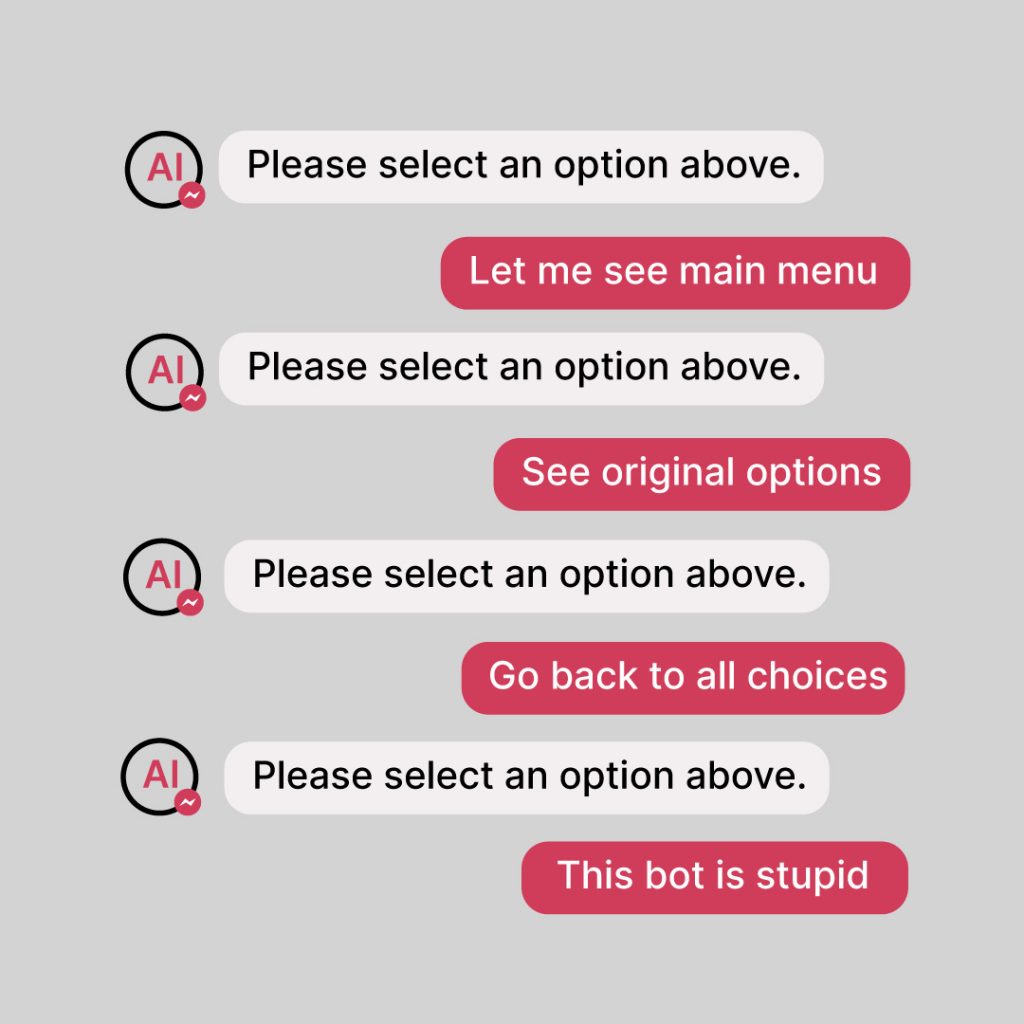Hey Alexa, what is conversational AI? If you’ve ever interacted with a virtual assistant like Siri, Alexa or Google Assistant, then you’ve experienced conversational Artificial Intelligence (AI). These game-changing automated messaging and speech-enabled applications have permeated every walk of life, creating human-like interactions between computers and humans. From checking your appointments and carrying out bank transactions, to tracking the status of your food or delivery order and learning the names of songs, conversational AI will soon be playing a lead role in your digital interactions.
So, how does Conversational AI work?
Users interact with conversational AI through text chats or voice. Simple FAQ chatbots require specific terms to derive responses from their knowledge bank. However, applications based on conversational AI are far more advanced – they can understand intent, provide responses in context, and learn and improve over time. While conversational AI is the umbrella term, there are underlying technologies such as Machine Learning (ML), Natural Language Processing (NLP), Natural Language Understanding (NLU) and Natural Language Generation (NLG) that enable text-based interactions. In the context of voice, additional technologies such as Automatic Speech Recognition (ASR) and text-to-speech software enable the computer to “talk” like a human.

Imagine you give a command to a conversational AI application to track your order. This input could either be spoken or text. If spoken, the ASR converts the spoken phrases into machine-readable language. Once converted by ASR, the application then moves into the NLP stage, where it first uses NLU to understand the context and intent of the message. Based on this, a response is formed through a dialogue management system and generated into an understandable format by NLG. The response is then either delivered in text, or in the case of voice, converted to speech through text-to-speech software. All this happens in a matter of seconds, to get the information you need about the status of your order.
Conversational AI will create a real and personal relationship between humans and technology
As our world becomes more digital, conversational AI can enable seamless communication between humans and machines, with interactions that are an integral part of daily life. Besides improved user engagement, conversational assistants allow round-the-clock business accessibility and reduce manual errors in sharing information. They reduce the dependency on people for multi-lingual support and enable inclusion by removing literacy barriers. The benefits and potential of conversational AI are inviting businesses and technology to make heavy investments in the space.
Sales, service and support have been early adopters of conversational AI, because of the structured nature of information exchange that these functions require. This has decreased query resolution times, reduced the dependence on human agents and provided the opportunity for 24/7 sales and service. The AI chatbots are even able to deliver recommendations on purchases based on personalized customer preferences. According to Gartner, chatbots and conversational agents will raise and resolve a billion service tickets by 2030.
Across sectors, conversational AI is transforming interactions between people and systems. The banking sector is banking on conversational AI to provide a superior experience through transactions such as providing balance information, paying bills, marketing offers and products and so on, all without human intervention. The insurance sector is using chatbots to help customers choose a policy, submit documents, handle customer queries, renew policies and more. The healthcare sector is using these chatbots to check patient symptoms, schedule appointments, maintain patients’ medical data, and share medication and routine check-up reminders. Automobiles are becoming a cockpit for personal AI assistants or in-car experiences.
Businesses are also using conversational AI to manage their own workforce and improve the employee experience. Through chatbots, they make vital information available to employees 24/7, reducing the need for human resources to manage queries and processes. The possibilities and opportunities with conversational AI are endless and use cases are available in every industry.
Overcoming user frustration with Conversational AI through better engineering and design
While there are several benefits to conversational AI, you might be familiar with many instances when the conversation ends in frustration. As AI technology evolves and matures, these challenges must be addressed at the design and engineering stage.
In terms of design, the success of the platform entirely hinges on user interface and experience. It must be easy to use, intuitive, and must fit seamlessly into the overall design of the application and customer journey. While UI is important, the conversation itself is the most critical aspect. It is important to ensure that the conversational design flows smoothly, follows well-tested and widely applicable patterns and has exception rules inbuilt into the script design.
The more human-like the conversation is, the better the user’s acceptance
- Draw from real life – To design a fulfilling conversation, architects and UX designers must draw from real-life, and UX design principles. The product has to be designed for ease of use, ease of conversation and ease of resolution. The product has to be easily findable, accessible and usable to the user in the overall product ecosystem. This can be achieved by following time-tested UI and UX principles in developing visual or auditory experiences.
- Build trust – To build trust in conversational AI, small talk or playful ways to engage with the AI can be built into the engagement.
- Understand the target audience – Understanding the target audience and their needs is pivotal to the success of conversational AI. An in-depth study of the demographics helps in building a platform that is unbiased. Incorporating languages, accents and cultural nuances allows the user to relate better and enable smoother interactions.
- Solve customer problems, not business problems – A deep understanding of the customer ensures that the conversation design is solving for the customer, rather than solving for the business problem. When the focus is on the business problem, the is a possibility of ignoring the human-like flow of interaction. Putting the customer first helps in building a valuable and desirable interface that is a win-win for both the customer and the business. It is also important to ask what the system will help resolve and design the conversation to ensure the most frequent use cases for the application are solved logically and seamlessly.
 Example of a bad AI chatbot interaction
Example of a bad AI chatbot interaction - Recover from lagging conversations – The AI bot must also have the ability to learn from mistakes, recover from broken conversations and redirect to human agents when conversations cannot be fulfilled through AI. This has to be designed seamlessly into the interface, ensuring the customers trust the system and come back to use it in the future.
Engineering can help provide human-like interaction
- The systems have to be able to deal with noisy settings and decipher languages, dialects, accents, sarcasm, and slang that could influence intent in the conversation. Intense data training, larger varied datasets, language training and machine learning (ML) could solve these challenges as the technology matures.
- Another concern with conversational AI is data privacy and protection. To gain user trust, security must be paramount and all regional privacy laws must be adhered to.
- Backend integration of conversational AI platforms may decide their success or failure in the market. The platform must integrate with CRM, after-sales, ticketing, databases, analytics systems and so on, to get appropriate data for the user, and provide appropriate data to the business.
- Finally, the AI system should be backed by analytics and data, so that data scientists have invaluable insights to continuously improve the system.
Conversational AI is growing at an incredible pace and at a massive scale. This is because of the immense possibility that conversational AI has to bridge the gap between humans and technology. There is vast demand also due to the efficiencies and cost savings that conversational AI can offer businesses with quick, accurate and effortless query resolution. Businesses across industries should leverage this technology of the future to deliver a consistent and superior user experience.





